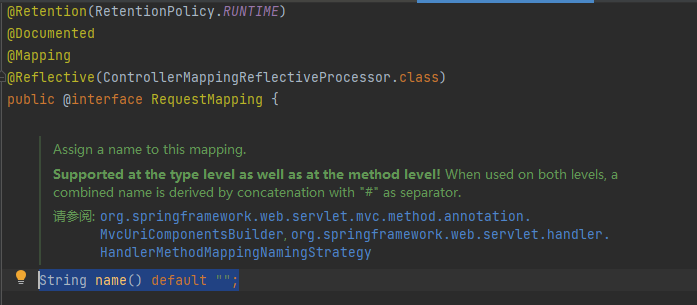@RequestMapping的使用以及其中的name属性解释
- 接受前端发送的post请求
//发送请求方式为post请求,则可以正常映射 // @RequestMapping(value = "/user/login",method = {RequestMethod.POST}) @PostMapping(value={"/user/login"}) public String userLogin(){ System.out.println("处理登录业务"); return "ok"; }
@RequestMapping(value = "/user/login",method = {RequestMethod.POST})等价与@PostMapping(value={"/user/login"})
因为@PostMapping,使用该注解时,不需要指定method属性,因为它默认采用的就是POST处理方式;类似的还用
GetMapping:要求前端必须发送get请求
PutMapping:要求前端必须发送put请求
DeleteMapping:要求前端必须发送delete请求
PatchMapping:要求前端必须发送patch请求
- 前端html代码
*** <body> <!--发送POST请求--> <form th:action="@{/user/login}" method="post"> 用户名: <input type="text" name="username"/><br> 密码: <input type="password" name="password"/><br> <input type="submit" value="登录"> </form> </body> </html>

在Spring MVC中,@RequestMapping注解用于映射web请求到特定的处理方法。这个注解有多个属性,其中之一就是name。name属性通常用于为映射提供一个名称,这个名称可以在日志、文档或其他需要引用这个映射的地方使用。
在Spring MVC的上下文中,这允许你为特定的@RequestMapping映射指定一个名称,例如:
@RequestMapping(value = "/hello", method = RequestMethod.GET, name = "helloEndpoint") public String hello() { // ... return "hello"; }
在这个例子中,/hello的GET请求被映射到hello()方法,并且这个映射有一个名为helloEndpoint的名称。
然而,需要注意的是,name属性在Spring MVC的@RequestMapping注解中并不是核心功能的一部分,并且在所有场景下都不一定被使用或支持。在某些情况下,它可能只是用于内部引用或日志记录。
此外,由于@RequestMapping可以映射到不同的HTTP方法(如GET、POST、PUT等),Spring团队还创建了特定的注解(如@GetMapping、@PostMapping等)作为@RequestMapping的简化版本。这些特定的注解通常没有name属性,因为它们的用途更加明确,并且通常不需要额外的名称来区分。但是,你仍然可以使用@RequestMapping并提供name属性,如果你认为这样做有帮助的话。
- @RequestMapping注解的method属性是一个RequestMethod类型的数组,用于指定该映射应该匹配哪些HTTP方法。如果你不提供这个属性,那么默认的行为是匹配所有的HTTP方法。





【推荐】国内首个AI IDE,深度理解中文开发场景,立即下载体验Trae
【推荐】编程新体验,更懂你的AI,立即体验豆包MarsCode编程助手
【推荐】抖音旗下AI助手豆包,你的智能百科全书,全免费不限次数
【推荐】轻量又高性能的 SSH 工具 IShell:AI 加持,快人一步
· 无需6万激活码!GitHub神秘组织3小时极速复刻Manus,手把手教你使用OpenManus搭建本
· C#/.NET/.NET Core优秀项目和框架2025年2月简报
· Manus爆火,是硬核还是营销?
· 终于写完轮子一部分:tcp代理 了,记录一下
· 【杭电多校比赛记录】2025“钉耙编程”中国大学生算法设计春季联赛(1)